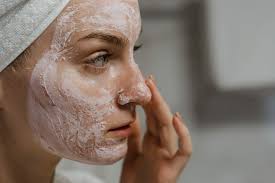
Should I Exfoliate Before I Use My Face Mask?
If you have ever had a facial, you will know the amount of time and effort there is involved to give you those spa-like results of glowing, baby soft skin. With a professional facial you can expect to have 3 to 4, maybe more steps taken into perfecting the skin, each designed to treat the various layers of the skin. With this in mind it makes you wonder why, when using a at home face mask we sometimes apply it without taking the time to include these extra steps.
This is when exfoliation before applying a face mask can really up the luxe factor and give your skin the extra TLC you experience during a professional treatment. So today we are going to example why you should exfoliate when using a face mask.
Should I exfoliate before or after a face mask?
To ensure your skin gets the best form of care from using face masks and other steps in your routine, you should follow some basic rules in skin maintenance. By this we mean to always ensure your skin is completely clear of makeup and cleansed of any bacteria or debris before applying a face mask. By doing this you are preventing any impurities from becoming blocked on the skin by a layer of clay, mud or cream mask. This can usually result in the pores becoming clogged and cause the skin to breakout with spots and blackheads.
When it comes to the added step of exfoliating the skin, it is thought best to do this after cleansing the skin and before applying your face mask. This helps to keep the face clean and removes any remaining traces and build-up of product whilst dead skin cells are sloughed away with the exfoliating particles. You will then find the active ingredients in your chosen face mask can deliver faster and more impressive results to the complexion, leaving it glowing, detoxified and healthy. If you are wanting to find out more about face masks and how the different formulas can benefit the skin, you can check out the previous blog about how often you should use a face mask in your skincare routine.
You should then follow the removal of your face mask with a toner, however, ensure it does not have any AHAs or BHAs in the formula as this can be too much for the skin and cause dryness and breakouts.
Is it ok to use face mask after exfoliating?
This should be absolutely fine as long as you ensure the formula of the face mask does not contain any chemical exfoliates, or other potent ingredients that could cause too much stress for the skin. It is also best to avoid any peel off masks as this could lead to the skin feeling tight and stripped of vital water and sebum levels in the skin. When an imbalance such as this is created the skin usually overcompensates and begins to over-produce sebum to help restore the skin’s natural protective barrier, all of which results in a number of inflammations, from breakouts, redness and flaky dry areas of the skin.
Can you exfoliate and do a mask on the same day?
You can indeed! As previously mentioned, you should only exfoliate the skin before a face mask, if there are no AHAs, BHAs or other chemical exfoliating ingredients included in any of the following steps in your skincare routine.
Skincare routine when exfoliating
Remove makeup
Cleanse the skin with non-foaming cleanser
Exfoliate with physical scrub or cotton pad soaked in chemical exfoliant
Apply clay, mud or cream face mask
Rinse and remove any residue with floral toner containing no exfoliants
Applying hydrating serum
Eye cream
Moisturiser
Daily SPF (AM routine only)
Skincare routine without exfoliating
Remove makeup
Cleanse the skin with non-foaming cleanser
Apply face mask of choice, including peel away formulas
Lightly wipe the skin with AHA toner-soaked cotton pad
Apply liberal amounts of serum containing hyaluronic acid or niacinamide
Eye cream
Moisturiser
Daily SPF (AM routine only)
To get a better understanding of which routine would best suit you and your skin type, you can give both a try, making note of how your skin feels and looks afterwards. Once you have found the right routine you will find your skin will look better than ever with congested pores cleared, texture feeling and looking smoother and any flare-ups or breakouts notably reduced.
What should I do after wearing a mask?
After using a face mask you should continue with the other steps in your skincare routine. Remembering, of course to include active ingredients that will nourish, protect and rejuvenate the skin by keeping it at its healthiest state.
You will find that the following ingredients should work for your skin type, if you find you have a more dry or sensitive skin type, then it is best to consult your doctor or dermatologist for peace of mind. As always, we strongly suggest you perform a patch test for 24 hours with any new products or ingredients you are adding to your routine for the first time. This will avoid you suffering any skin flare-ups or irritation caused by ingredients that are too potent and harsh for your skin.
Hyaluronic acid
Niacinamide
Vitamin C (also known as ascorbic and L-ascorbic acid)
These active ingredients are the most hydrating and nourishing to the face, creating balance and restoring calm back to the outer layer of the skin that can frequently become damaged from exposure to free radicals, such as pollution, UV rays and other environmental stresses. We have linked our dedicated blog posts for you to find out more about all the skin benefits when using the mentioned ingredients.
We hope that today we have answered some of your questions about exfoliating the skin when using a face mask, it feels a shame to not take the extra time to perform an at home spa-like facial after all! If you find yourself giving this a try for yourselves using one of the many Procoal face masks available, then don’t forget to tag us in your face mask selfies on Instagram!
Don’t miss out on more skincare tips and expert advice over on our YouTube channel! Come and find us on The Green Sofa by hitting the subscribe button, you won’t regret it!


